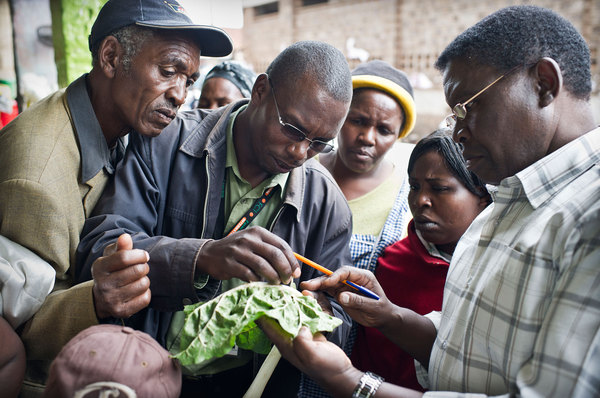Slicing Into The Bread Wheat Genome
Bread wheat (Triticum aestivum) is a globally important crop that accounts for 20% of the calories consumed by the world’s human population. Major work is underway to increase wheat production by expanding knowledge of the wheat genome and analysing key traits, however due to the large size and great complexity of the bread wheat genome…
Watermelon Genome Could Hold the Key to Improved Varieties With Fewer Pest Problems
A research team led by the Beijing Academy of Agriculture and Forestry Sciences have produced the complete genomic sequence of watermelon (Citrullus lanatus). It is hoped that the genomic data from this study will shape future research into watermelon genetics and provide a good resource for crop genetics and future plant breeding projects, resulting in…
Plantwise Plant Clinics in Trinidad and Tobago
Trinidad and Tobago Country Coordinator Shamela Rambadan sent the photo below of a Soursop (Annona muricata) plant brought into a clinic in County Victoria in Trinidad and Tobago by farmer Ramesh Ramnanan last month. The symptoms described included yellowed, distorted leaves and visible insects on the leaves, as seen in the photo. Plant health officer…
Coffee Production in Hot Water- The Impacts of Climate Change on the Future of Coffee Crops
Coffee (Coffea) is the one of the world’s favourite drinks and the second most traded commodity after oil, accounting for annual retail value of US$ 90 billion. The two main species used in the production of coffee are Arabica coffee (Coffea arabica), which accounts for 70% of coffee production, and Robusta coffee (Coffea canephora). The…
Experts suggest crops to replace those affected by climate change
Members of the banana family could become a vital food source for millions in developing countries, a new report suggests. The report was written by the Consultative Group on International Agricultural Research (CGIAR) after a request was made by the United Nations Framework Convention on Climate Change (UNFCCC). CGIAR looked at the effect of climate…
Plant Pest Interactions: How Soybean Aphids Trick Soybean Plant Defences
Following on from a previous blog on the interactions between soybean plants and soybean pests, new research on soybean (Glycine max) responses to the soybean aphid (Aphis glycines) published in Molecular Plant-Microbe Interactions has revealed some of the complex and fascinating interactions between pests and their plant hosts. This recent research led by Dr Gustavo Macintosh and…
World Food Prize Borlaug Dialogue 2012 highlights the real people affected by global food security issues
By Daniel O’Hara This year’s World Food Prize Borlaug Dialogue concluded on Friday with a breakfast address from the UN Secretary General, Ban Ki-moon, highlighting the importance of food security to global prosperity. The Secretary General’s attendance was an indicator of the importance of food security on the international agenda. He summed up the conference…
The Soybean Gene: Scientists Discover the Key to Nematode Resistant Soybeans
Soybean (Glycine max) is an important crop that provides a sustainable source of protein and oil worldwide in countries such as the USA, Brazil, Argentina, India and many African countries, including Nigeria, South Africa and Uganda. The soybean cyst nematode Heterodera glycines is a microscopic roundworm that feeds on the roots of soybean and is…
CABI at the World Food Prize
Today, the 16th October, is World Food Day. In today’s context of rising food insecurity, the timing could not be more fitting. This week global agricultural leaders will gather in Des Moines, Iowa for the World Food Prize & The Borlaug Dialogue. The World Food Prize will be awarded on Thursday 18th October to Dr.…
Sweet Like Chocolate: Breeding Programs Combating Fungal Diseases of Cocoa in Ecuador
Cocoa, Theobroma cacao L. is the third most important export product in Ecuador; a country which produces 70% of the world’s highly prized Arriba cocoa. However, the sustainability of this crop is threatened by a number of devastating pest species including fungal diseases and insect pests. Among the most severe are the closely related fungal diseases…

